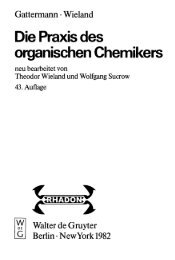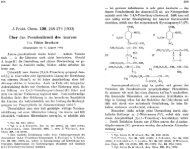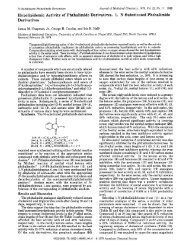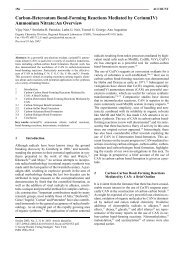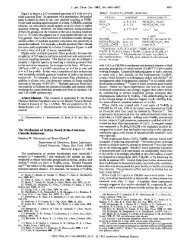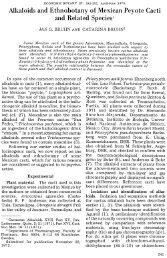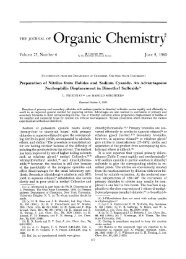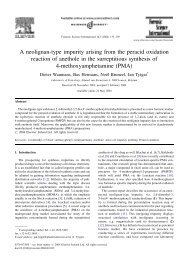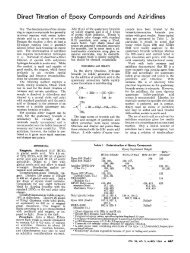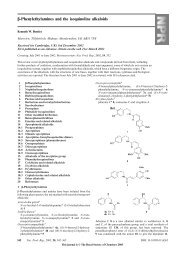You also want an ePaper? Increase the reach of your titles
YUMPU automatically turns print PDFs into web optimized ePapers that Google loves.
Alcohol Oxidations Mediated by N-Oxoammonium Salts J. <strong>Org</strong>. <strong>Chem</strong>., Vol. 55, No. 2, 1990 463<br />
Table 1. Oxidation of Undecanol (34 by N-Oxy1 (la)-NaBrO, andlor Ca(OCI), Caoxidants'<br />
product yield, %<br />
entry solvent (pH, v/v) oxidizing reagent 4a 5s 6a<br />
1<br />
2<br />
3<br />
CH,CI,-H,O (pH 8.6, 12)<br />
MeCN-H,O (pH 8.6, 1:l)<br />
AcOH-H.0 loH 2.2. 1:5)<br />
la (1 mol %)-NaBrO, (3 equiv)<br />
la (1 mol %)-NaBrOl (3 equiv)<br />
NaBrO. 13 eouidb<br />
93<br />
92<br />
92 _-<br />
5<br />
34<br />
"Unless otherwise noted, reactions were carried out by using 3a (1.0 mmol) in organic solvent (5 mL) and aqueous solution (5-10 mL) at<br />
raom temperature for 15-180 min. 'N-Oxy1 la was not present. c50 mmol of 3a was used see Experimental Section.<br />
0 15 30 45<br />
Time (min)<br />
Figure 1. Time-dependence curves for oxidation of undecanol<br />
(34 with N-oxy1 (la)-NaBrO, (-) or la-Ca(OCI), (---I system.<br />
Symbols are as follows: 5 mol % of la (0); 1 mol % of la (0);<br />
0.2 mol % of la (Oh in the absence of la (A). Data points were<br />
obtained by GC analyses based on an internal standard (bromononane).<br />
accelerated by increasing the catalyst amount and reasonable<br />
rates were obtained in the range 1-5 mol % of la.<br />
Routinely, we used 1 mol % of la (based on the substrate)<br />
for the oxidation, which facilitated the separation of<br />
products from the catalyst la by distillation or chromatograph~.'~<br />
Subsequently, the oxidation of 3a to 4a was attempted<br />
using the tetramethylpiperidine-1-oxy1 derivatives Ib, IC,<br />
and Id, affording 4a in 98% (with Ib), 85% (with IC), and<br />
97% yields (with Id). In contrast, di-tert-butylnitroxyl<br />
was not useful as a recycling catalyst.<br />
Competitive oxidation of 1-undecanol (3a) and 2-undecanol(7a)<br />
under the conditions of entry 1 (Table I) was<br />
examined at 0 OC, and the yields of undecanal (4a) and<br />
2-undecanone (8a) are plotted in Figure 2 as a function<br />
of the amount of sodium bromite. Aldehyde 4a was exclusively<br />
formed when less than 3 equiv of sodium bromite<br />
was used. Similarly, treatment of a 1:l mixture of l-dodecanol<br />
(3b) and 4-dodecanol (7b) with la (1 mol %)-<br />
NaBrO, (4 equiv) at 0 "C afforded dodecanal (4b) and<br />
4-dodecanone (8b) in 92% and 2% yields, respectively. In<br />
the latter case, the relative oxidation rates for 4b and 8b<br />
can be estimated to he in a ratio of 461. This value compares<br />
well with that obtained by the oxidation with ruthenium<br />
dichloride tris(tripheny1pbosphine) complex,<br />
(RuCI,(PPh,),), as a stoichiometric oxidant in benzene.14<br />
3b<br />
7b OH<br />
-CHO<br />
4b<br />
,----P,<br />
8b<br />
(13) After completion of the reaction, ex- oxidants can be removed<br />
by adding ethanol in the aldehyde synthesis or aqueous 5% sodium<br />
hydrogen sulfite in the ketone synthesis.<br />
.<br />
0 1.0 2.0 3.0 4.0<br />
NaBrOI (equivalent)<br />
Figure 2. Competitive oxidation of undecanol(3a) and 2-undecanol.<br />
Symbols me as follows: undecanal (o), 2-undecanone<br />
(0). Data points were based on isolated products.<br />
As an alternative oxygenated halogen oxidant, calcium<br />
hypochlorite (Ca(OCl),) could be used for the present<br />
purpose.15 As shown in entry 6 (Table I), the oxidation<br />
of 3a in a CH,CI,-H,O (buffered at pH 8.6, 1:2 v/v)-la<br />
(1 mol %)-Ca(OCI), (2.2 equiv) system at 0-5 "C gave<br />
aldehyde 4a in 90% yield. The oxidation of 3a with a<br />
laCa(OCI), system proceeded more rapidly than that with<br />
a la-NaBr02 system.16 On the other hand, the use of<br />
sodium chlorite (NaCIOJ and sodium periodide (NaIO,)<br />
as a stoichiometric oxidizing reagent was unsuccessful.<br />
In contrast to our present method, the recently developed<br />
4-methoxy-2,2,6,6-tetramethylpiperidine-l-oxyl (Id,<br />
catalytic)-KBr (catalytic)-NaOC1 (stoichiometric) system8<br />
needs ultrarapid agitation to complete the reaction quickly.<br />
Furthermore, the la-NaBrO, system can be operated<br />
easily in a large-scale p~eparation.'~<br />
The results from oxidation of a variety of primary and<br />
secondary alcohols are listed in Table 11. The oxidation<br />
of terminal 1,4- and 1,5-diols can lead toy- and &lactones<br />
(entries 16-19), while terminal l,&diols are converted to<br />
&hydroxy aldehydes (aldols) due to mild reaction conditions<br />
(entries 13-15). For the oxidation of secondary alcohols<br />
in 1,3-diol derivatives, the sodium hypochlorite<br />
acetic acid system, a typidy economical method, has been<br />
recognized as a particularly useful one.18 The present<br />
1141 Tomioka. H.: Takai, K.: Oihima. K.: Nomki, H. Tetrohedmn<br />
ktt. 1981, 22, 1605.<br />
(151 Oxidation with Cs(OCI12 in acetic acid Nwauks, S. D.; Keehn.<br />
P. M. Telrohpdron I.ett. 1982.23. . ~, 3131.<br />
~~~~~<br />
(16) The oxidation with la-Ca(OCI), wag carried out with a 0.2 M<br />
solution of substrate in CH2CI2, and Ca(OCI), was added portionwise to<br />
the reaction mixture. At about 1 M concentration loss of N-oxy1 compounds<br />
occurred prior to the end point.<br />
(11) The oxidation of 3a (10 mmol) with a combination of la (0.1<br />
mmol) and KBr (1 mmol)-NaOCI (30 mmoll in B CH,CI, (50 mL)aqueous<br />
5% NaHCO, (45 mL) at &5 OC for 3 h resulted in the formation<br />
of 4a (35%) and recovery of the starting 3a (64%).




